+ データを開く
データを開く
- 基本情報
基本情報
| 登録情報 | データベース: PDB / ID: 6hum | ||||||||||||||||||||||||
|---|---|---|---|---|---|---|---|---|---|---|---|---|---|---|---|---|---|---|---|---|---|---|---|---|---|
| タイトル | Structure of the photosynthetic complex I from Thermosynechococcus elongatus | ||||||||||||||||||||||||
 要素 要素 |
| ||||||||||||||||||||||||
 キーワード キーワード | PROTON TRANSPORT / Respiratory Complex / Ferredoxin / Cyclic electron flow / Complex I / Membrane protein complex | ||||||||||||||||||||||||
| 機能・相同性 |  機能・相同性情報 機能・相同性情報トランスロカーゼ; ヒドロンの輸送の触媒; 酸化還元酵素反応を伴う / NADH dehydrogenase complex / transmembrane transporter complex / photosynthetic electron transport chain / oxidoreductase activity, acting on NAD(P)H, quinone or similar compound as acceptor / NADH dehydrogenase activity / plasma membrane-derived thylakoid membrane / photosynthesis, light reaction / ubiquinone binding / electron transport coupled proton transport ...トランスロカーゼ; ヒドロンの輸送の触媒; 酸化還元酵素反応を伴う / NADH dehydrogenase complex / transmembrane transporter complex / photosynthetic electron transport chain / oxidoreductase activity, acting on NAD(P)H, quinone or similar compound as acceptor / NADH dehydrogenase activity / plasma membrane-derived thylakoid membrane / photosynthesis, light reaction / ubiquinone binding / electron transport coupled proton transport / respiratory chain complex I / NADH dehydrogenase (ubiquinone) activity / quinone binding / ATP synthesis coupled electron transport / endomembrane system / aerobic respiration / NAD binding / 4 iron, 4 sulfur cluster binding / iron ion binding / membrane / plasma membrane 類似検索 - 分子機能 | ||||||||||||||||||||||||
| 生物種 |   Thermosynechococcus elongatus BP-1 (バクテリア) Thermosynechococcus elongatus BP-1 (バクテリア) | ||||||||||||||||||||||||
| 手法 | 電子顕微鏡法 / 単粒子再構成法 / クライオ電子顕微鏡法 / 解像度: 3.34 Å | ||||||||||||||||||||||||
 データ登録者 データ登録者 | Schuller, J.M. / Schuller, S.K. / Kurisu, G. / Engel, B.D. / Nowaczyk, M.M. | ||||||||||||||||||||||||
| 資金援助 |  ドイツ, ドイツ,  日本, 日本,  オーストラリア, 7件 オーストラリア, 7件
| ||||||||||||||||||||||||
 引用 引用 |  ジャーナル: Science / 年: 2019 ジャーナル: Science / 年: 2019タイトル: Structural adaptations of photosynthetic complex I enable ferredoxin-dependent electron transfer. 著者: Jan M Schuller / James A Birrell / Hideaki Tanaka / Tsuyoshi Konuma / Hannes Wulfhorst / Nicholas Cox / Sandra K Schuller / Jacqueline Thiemann / Wolfgang Lubitz / Pierre Sétif / Takahisa ...著者: Jan M Schuller / James A Birrell / Hideaki Tanaka / Tsuyoshi Konuma / Hannes Wulfhorst / Nicholas Cox / Sandra K Schuller / Jacqueline Thiemann / Wolfgang Lubitz / Pierre Sétif / Takahisa Ikegami / Benjamin D Engel / Genji Kurisu / Marc M Nowaczyk /     要旨: Photosynthetic complex I enables cyclic electron flow around photosystem I, a regulatory mechanism for photosynthetic energy conversion. We report a 3.3-angstrom-resolution cryo-electron microscopy ...Photosynthetic complex I enables cyclic electron flow around photosystem I, a regulatory mechanism for photosynthetic energy conversion. We report a 3.3-angstrom-resolution cryo-electron microscopy structure of photosynthetic complex I from the cyanobacterium The model reveals structural adaptations that facilitate binding and electron transfer from the photosynthetic electron carrier ferredoxin. By mimicking cyclic electron flow with isolated components in vitro, we demonstrate that ferredoxin directly mediates electron transfer between photosystem I and complex I, instead of using intermediates such as NADPH (the reduced form of nicotinamide adenine dinucleotide phosphate). A large rate constant for association of ferredoxin to complex I indicates efficient recognition, with the protein subunit NdhS being the key component in this process. | ||||||||||||||||||||||||
| 履歴 |
|
- 構造の表示
構造の表示
| ムービー |
 ムービービューア ムービービューア |
|---|---|
| 構造ビューア | 分子:  Molmil Molmil Jmol/JSmol Jmol/JSmol |
- ダウンロードとリンク
ダウンロードとリンク
- ダウンロード
ダウンロード
| PDBx/mmCIF形式 |  6hum.cif.gz 6hum.cif.gz | 761.3 KB | 表示 |  PDBx/mmCIF形式 PDBx/mmCIF形式 |
|---|---|---|---|---|
| PDB形式 |  pdb6hum.ent.gz pdb6hum.ent.gz | 601.1 KB | 表示 |  PDB形式 PDB形式 |
| PDBx/mmJSON形式 |  6hum.json.gz 6hum.json.gz | ツリー表示 |  PDBx/mmJSON形式 PDBx/mmJSON形式 | |
| その他 |  その他のダウンロード その他のダウンロード |
-検証レポート
| 文書・要旨 |  6hum_validation.pdf.gz 6hum_validation.pdf.gz | 911.6 KB | 表示 |  wwPDB検証レポート wwPDB検証レポート |
|---|---|---|---|---|
| 文書・詳細版 |  6hum_full_validation.pdf.gz 6hum_full_validation.pdf.gz | 956.8 KB | 表示 | |
| XML形式データ |  6hum_validation.xml.gz 6hum_validation.xml.gz | 99 KB | 表示 | |
| CIF形式データ |  6hum_validation.cif.gz 6hum_validation.cif.gz | 153.2 KB | 表示 | |
| アーカイブディレクトリ |  https://data.pdbj.org/pub/pdb/validation_reports/hu/6hum https://data.pdbj.org/pub/pdb/validation_reports/hu/6hum ftp://data.pdbj.org/pub/pdb/validation_reports/hu/6hum ftp://data.pdbj.org/pub/pdb/validation_reports/hu/6hum | HTTPS FTP |
-関連構造データ
- リンク
リンク
- 集合体
集合体
| 登録構造単位 | 
|
|---|---|
| 1 |
|
- 要素
要素
-NAD(P)H-quinone oxidoreductase subunit ... , 12種, 12分子 ACEBJHIKLNMO
| #1: タンパク質 | 分子量: 40565.984 Da / 分子数: 1 / 由来タイプ: 天然 由来: (天然)   Thermosynechococcus elongatus BP-1 (バクテリア) Thermosynechococcus elongatus BP-1 (バクテリア)参照: UniProt: Q8DL32, 酸化還元酵素; キノンおよび類縁体が電子受容体 |
|---|---|
| #2: タンパク質 | 分子量: 15013.919 Da / 分子数: 1 / 由来タイプ: 天然 由来: (天然)   Thermosynechococcus elongatus BP-1 (バクテリア) Thermosynechococcus elongatus BP-1 (バクテリア)参照: UniProt: Q8DJ02, 酸化還元酵素; キノンおよび類縁体が電子受容体 |
| #4: タンパク質 | 分子量: 11140.265 Da / 分子数: 1 / 由来タイプ: 天然 由来: (天然)   Thermosynechococcus elongatus BP-1 (バクテリア) Thermosynechococcus elongatus BP-1 (バクテリア)参照: UniProt: Q8DL29, 酸化還元酵素; キノンおよび類縁体が電子受容体 |
| #5: タンパク質 | 分子量: 55168.543 Da / 分子数: 1 / 由来タイプ: 天然 由来: (天然)   Thermosynechococcus elongatus BP-1 (バクテリア) Thermosynechococcus elongatus BP-1 (バクテリア)参照: UniProt: Q8DMR6, 酸化還元酵素; キノンおよび類縁体が電子受容体 |
| #7: タンパク質 | 分子量: 19363.789 Da / 分子数: 1 / 由来タイプ: 天然 由来: (天然)   Thermosynechococcus elongatus BP-1 (バクテリア) Thermosynechococcus elongatus BP-1 (バクテリア)参照: UniProt: Q8DJ01, 酸化還元酵素; キノンおよび類縁体が電子受容体 |
| #9: タンパク質 | 分子量: 45271.184 Da / 分子数: 1 / 由来タイプ: 天然 由来: (天然)   Thermosynechococcus elongatus BP-1 (バクテリア) Thermosynechococcus elongatus BP-1 (バクテリア)参照: UniProt: Q8DJD9, 酸化還元酵素; キノンおよび類縁体が電子受容体 |
| #10: タンパク質 | 分子量: 22444.801 Da / 分子数: 1 / 由来タイプ: 天然 由来: (天然)   Thermosynechococcus elongatus BP-1 (バクテリア) Thermosynechococcus elongatus BP-1 (バクテリア)参照: UniProt: Q8DL31, 酸化還元酵素; キノンおよび類縁体が電子受容体 |
| #11: タンパク質 | 分子量: 25766.998 Da / 分子数: 1 / 由来タイプ: 天然 由来: (天然)   Thermosynechococcus elongatus BP-1 (バクテリア) Thermosynechococcus elongatus BP-1 (バクテリア)参照: UniProt: Q8DKZ4, 酸化還元酵素; キノンおよび類縁体が電子受容体 |
| #12: タンパク質 | 分子量: 8575.137 Da / 分子数: 1 / 由来タイプ: 天然 由来: (天然)   Thermosynechococcus elongatus BP-1 (バクテリア) Thermosynechococcus elongatus BP-1 (バクテリア)参照: UniProt: Q8DKZ3, 酸化還元酵素; キノンおよび類縁体が電子受容体 |
| #14: タンパク質 | 分子量: 16656.182 Da / 分子数: 1 / 由来タイプ: 天然 由来: (天然)   Thermosynechococcus elongatus BP-1 (バクテリア) Thermosynechococcus elongatus BP-1 (バクテリア)参照: UniProt: Q8DJU2, 酸化還元酵素; キノンおよび類縁体が電子受容体 |
| #15: タンパク質 | 分子量: 12584.056 Da / 分子数: 1 / 由来タイプ: 天然 由来: (天然)   Thermosynechococcus elongatus BP-1 (バクテリア) Thermosynechococcus elongatus BP-1 (バクテリア)参照: UniProt: Q8DLN5, 酸化還元酵素; キノンおよび類縁体が電子受容体 |
| #17: タンパク質 | 分子量: 7877.076 Da / 分子数: 1 / 由来タイプ: 天然 由来: (天然)   Thermosynechococcus elongatus BP-1 (バクテリア) Thermosynechococcus elongatus BP-1 (バクテリア)参照: UniProt: Q8DMU4, 酸化還元酵素; キノンおよび類縁体が電子受容体 |
-タンパク質 , 2種, 2分子 DS
| #3: タンパク質 | 分子量: 57847.504 Da / 分子数: 1 / 由来タイプ: 天然 由来: (天然)   Thermosynechococcus elongatus BP-1 (バクテリア) Thermosynechococcus elongatus BP-1 (バクテリア)参照: UniProt: Q8DKY0, 酸化還元酵素; キノンおよび類縁体が電子受容体 |
|---|---|
| #16: タンパク質 | 分子量: 12462.559 Da / 分子数: 1 / 由来タイプ: 天然 由来: (天然)   Thermosynechococcus elongatus BP-1 (バクテリア) Thermosynechococcus elongatus BP-1 (バクテリア)参照: UniProt: Q8DL61 |
-NADH dehydrogenase subunit ... , 2種, 2分子 GF
| #6: タンパク質 | 分子量: 21580.568 Da / 分子数: 1 / 由来タイプ: 天然 由来: (天然)   Thermosynechococcus elongatus BP-1 (バクテリア) Thermosynechococcus elongatus BP-1 (バクテリア)参照: UniProt: Q8DL30 |
|---|---|
| #13: タンパク質 | 分子量: 72025.352 Da / 分子数: 1 / 由来タイプ: 天然 由来: (天然)   Thermosynechococcus elongatus BP-1 (バクテリア) Thermosynechococcus elongatus BP-1 (バクテリア)参照: UniProt: Q8DKX9 |
-Proton-translocating NADH-quinone dehydrogenase subunit ... , 2種, 2分子 PQ
| #8: タンパク質・ペプチド | 分子量: 4630.392 Da / 分子数: 1 / 由来タイプ: 天然 由来: (天然)   Thermosynechococcus elongatus BP-1 (バクテリア) Thermosynechococcus elongatus BP-1 (バクテリア) |
|---|---|
| #18: タンパク質・ペプチド | 分子量: 4206.993 Da / 分子数: 1 / 由来タイプ: 天然 由来: (天然)   Thermosynechococcus elongatus BP-1 (バクテリア) Thermosynechococcus elongatus BP-1 (バクテリア) |
-非ポリマー , 3種, 5分子 




| #19: 化合物 | ChemComp-BCR / |
|---|---|
| #20: 化合物 | ChemComp-LMG / |
| #21: 化合物 |
-実験情報
-実験
| 実験 | 手法: 電子顕微鏡法 |
|---|---|
| EM実験 | 試料の集合状態: PARTICLE / 3次元再構成法: 単粒子再構成法 |
- 試料調製
試料調製
| 構成要素 | 名称: photosynthetic complex I / タイプ: COMPLEX / Entity ID: #1-#18 / 由来: NATURAL |
|---|---|
| 由来(天然) | 生物種:   Thermosynechococcus elongatus (strain BP-1) (バクテリア) Thermosynechococcus elongatus (strain BP-1) (バクテリア) |
| 緩衝液 | pH: 8 |
| 試料 | 包埋: NO / シャドウイング: NO / 染色: NO / 凍結: YES |
| 急速凍結 | 凍結剤: ETHANE-PROPANE |
- 電子顕微鏡撮影
電子顕微鏡撮影
| 実験機器 |  モデル: Titan Krios / 画像提供: FEI Company |
|---|---|
| 顕微鏡 | モデル: FEI TITAN KRIOS |
| 電子銃 | 電子線源:  FIELD EMISSION GUN / 加速電圧: 300 kV / 照射モード: FLOOD BEAM FIELD EMISSION GUN / 加速電圧: 300 kV / 照射モード: FLOOD BEAM |
| 電子レンズ | モード: BRIGHT FIELD |
| 撮影 | 電子線照射量: 49.93 e/Å2 フィルム・検出器のモデル: GATAN K2 SUMMIT (4k x 4k) |
- 解析
解析
| CTF補正 | タイプ: PHASE FLIPPING AND AMPLITUDE CORRECTION |
|---|---|
| 3次元再構成 | 解像度: 3.34 Å / 解像度の算出法: FSC 0.143 CUT-OFF / 粒子像の数: 133485 / 対称性のタイプ: POINT |
 ムービー
ムービー コントローラー
コントローラー














 PDBj
PDBj












